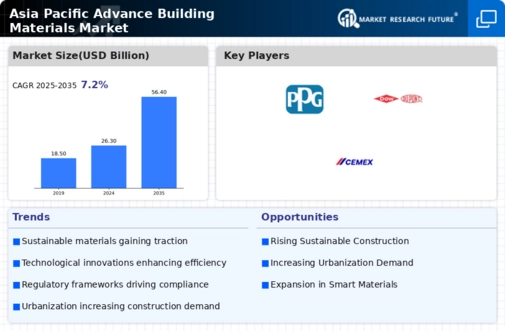Top Industry Leaders in the Asia Pacific Advance Building Materials Market
 The Asia Pacific region, with its booming construction sector and growing urbanization, presents a fertile ground for the advanced building materials market. These innovative materials, offering superior performance, sustainability, and cost-effectiveness, are transforming the way buildings are designed and constructed. But beneath the surface lies a dynamic and competitive landscape, where players vie for market share through strategic planning, technological advancements, and regional adaptability.
The Asia Pacific region, with its booming construction sector and growing urbanization, presents a fertile ground for the advanced building materials market. These innovative materials, offering superior performance, sustainability, and cost-effectiveness, are transforming the way buildings are designed and constructed. But beneath the surface lies a dynamic and competitive landscape, where players vie for market share through strategic planning, technological advancements, and regional adaptability.
A Spectrum of Players Shaping the Skyline:
-
Global Giants: Leading the pack are established multinationals like Saint-Gobain (France), LafargeHolcim (Switzerland), BASF (Germany), and PPG Industries (US) with extensive product portfolios, global reach, and strong R&D capabilities. -
Regional Champions: Companies like Nippon Steel & Sumitomo Metal Corporation (Japan), JSW Group (India), and China National Building Material Group Corporation (China) cater to specific regional needs and offer competitive pricing. -
Niche Innovators: Smaller players like Kingspan Group (Ireland), James Hardie Industries plc (Ireland), and Sekisui Chemical Co., Ltd. (Japan) focus on specialized materials like prefabricated panels, fiber cement boards, and energy-efficient insulation, pushing the boundaries of innovation.
Strategies for Building a Strong Foundation:
-
Innovation Focus: Developing new materials with improved strength, durability, thermal efficiency, and recyclability is crucial for staying ahead of the curve. Examples include self-healing concrete, bio-based insulation, and lightweight composites. -
Localization and Customization: Adapting products and services to diverse regional requirements, cultural preferences, and building regulations is essential for capturing local market share. -
Sustainability Commitment: Implementing eco-friendly manufacturing processes, utilizing recycled materials, and offering low-carbon solutions resonate with environmentally conscious clients and regulatory requirements. -
Vertical Integration: Integrating upstream raw material production with downstream manufacturing ensures control over quality, cost, and responsiveness to market demands. -
Strategic Partnerships: Collaborations with architects, contractors, and material suppliers facilitate project-specific solutions, joint innovation, and efficient distribution networks.
Factors Shaping Market Share:
-
Rapid Urbanization: The exponential growth of cities across Asia Pacific drives demand for new construction, creating significant opportunities for advanced building materials. -
Infrastructure Development: Government investments in roads, bridges, and public infrastructure projects present lucrative contracts for manufacturers and suppliers. -
Green Building Movement: Growing awareness of sustainability encourages the adoption of energy-efficient and eco-friendly building materials, shaping product development strategies. -
Technological Advancements: Innovations in prefabrication, 3D printing, and digital construction techniques create new possibilities and disrupt traditional methods. -
Economic Fluctuations: Fluctuations in regional economies and variations in currency exchange rates can impact market dynamics and investment decisions.
Key Companies in the advance building materials market include
-
Oerlikon Balzers Coating India Limited
-
PPG Industries Inc.
-
Saint-Gobain group
-
Sherwin-Williams Company
-
APV Engineered Coatings Inc.
-
BASF SE
-
Kingspan Group Plc
-
DowDupont Inc.
-
Cemex
-
Knauf Gips KG
Recent Developments:
-
August 2023: Saint-Gobain announces a new partnership with a local construction company in India to develop prefabricated building solutions for affordable housing projects. -
September 2023: LafargeHolcim unveils a new line of low-carbon concrete mixes in China, catering to the growing demand for sustainable building materials. -
October 2023: BASF partners with a leading research institute in Japan to develop self-healing concrete technologies for enhanced building durability. -
November 2023: PPG Industries invests in a recycling facility in Australia to process used architectural coatings and promote circular economy practices. -
December 2023: Nippon Steel & Sumitomo Metal Corporation collaborates with a government agency in Thailand to develop earthquake-resistant building materials for public infrastructure projects.

